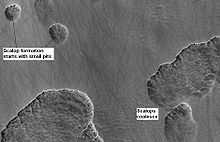Scalloped topography
Scalloped topography is common in the mid-latitudes of Mars, between 45° and 60° north and south. It is particularly prominent in the region of Utopia Planitia,[1][2] in the northern hemisphere, and in the region of Peneus and Amphitrites Paterae[3][4] in the southern hemisphere. Such topography consists of shallow, rimless depressions with scalloped edges, commonly referred to as "scalloped depressions" or simply "scallops". Scalloped depressions can be isolated or clustered and sometimes seem to coalesce. A typical scalloped depression displays a gentle equator-facing slope and a steeper pole-facing scarp.[5] This topographic asymmetry is probably due to differences in insolation. Scalloped depressions are believed to form from the removal of subsurface material, possibly interstitial ice, by sublimation (direct transition of a material from the solid to the gas phase with no intermediate liquid stage). This process may still be happening at present.[6] In Utopia Planitia, a series of curvilinear ridges parallel to the scarp are etched on the floor of large scalloped depressions, possibly representing different stages of scarp erosion.[1] Recently, other researchers have advanced an idea that the ridges represent the tops of layers.[7] Sometimes the surface around scalloped terrain or scalloped topography displays "patterned ground", characterized by a regular pattern of polygonal fractures. These patterns indicate that the surface has undergone stress, perhaps caused by subsidence, desiccation, or thermal contraction.[8] Such patterns are common in periglacial areas on Earth. Scalloped terrains in Utopia Planitia display polygonal features of different sizes: small (about 5–10 m across) on the scarp, and larger (30–50 m across) on the surrounding terrains. These scale differences may indicate local difference in ground ice concentrations.[1]
-
Scalloped terrain at Peneus Patera, as seen by HiRISE. Scalloped terrain is quite common in some areas of Mars. Image is from the Noachis quadrangle.
-
Periglacial forms in Utopia, as seen by HiRISE. Click on image to see patterned ground and scalloped topography. Image in Casius quadrangle.
-
Mad Vallis, as seen by HiRISE. Picture on right is an enlargement of part of the other picture. Click on image to see scalloped terrain. Image in Hellas quadrangle.
-

Scalloped ground, as seen by HiRISE under HiWish program.
-

Close up of scalloped ground, as seen by HiRISE under HiWish program. Surface is divided into polygons; these forms are common where ground freezes and thaws. Note: this is an enlargement of a previous image.
-

Scalloped ground, as seen by HiRISE under HiWish program.
-

Close-up of scalloped ground, as seen by HiRISE under HiWish program. Surface is divided into polygons; these forms are common where ground freezes and thaws. Note: this is an enlargement of a previous image.
-

Stages in scallop formation, as seen by HiRISE. Location is Hellas quadrangle.
-

Periglacial Scallops and polygons, as seen by HiRISE under HiWish program.
-
Mad Vallis, as seen by HiRISE. Picture on right is an enlargement of part of the other picture. Click on image to see scalloped terrain. Image in Hellas quadrangle.
-

Possible variation of scalloped terrain in depressions with straight southern walls, as seen by HiRISE under HiWish program. Box indicates part enlarged in images below. Image located in Diacria quadrangle in Milankovic crater.
-

Enlargement of above image of straight walled depression, as seen by HiRISE under HiWish program. Note that the southern wall is dark compared to the northern wall.
-

Further enlargement of above image, as seen by HiRISE under HiWish program.
References
- ↑ 1.0 1.1 1.2 Lefort, A., Russell, P., Thomas, N., McEwen, A.S., Dundas, C.M. and Kirk, R.L. (2009), "HiRISE observations of periglacial landforms in Utopia Planitia", Journal of Geophysical Research, vol. 114, E04005, doi:10.1029/2008JE003264.
- ↑ Morgenstern A, Hauber E, Reiss D, van Gasselt S, Grosse G, Schirrmeister L (2007): Deposition and degradation of a volatile-rich layer in Utopia Planitia, and implications for climate history on Mars. Journal of Geophysical Research - Planets 112, E06010.
- ↑ Lefort, A., Russell, P., Thomas, N. (2009) "Scalloped terrains in the Peneus and Amphitrites Paterae region of Mars as observed by HiRISE", Icarus, in Press doi:10.1016/j.icarus.2009.06.005
- ↑ Zanetti, M., Hiesinger,H., Reiss, D., Hauber, E. and Neukum, G. (2009), "Scalloped Depression Development on Malea Planum and the Southern Wall of the Hellas Basin, Mars", 40th Lunar and Planetary Science Conference, abstract 2178
- ↑ http://www.uahirise.org/ESP_038821_1235
- ↑ "Scalloped Topography in Peneus Patera Crater". HiRISE Operations Center. 2007-02-28. Retrieved 2014-11-24.
- ↑ Sejourne, A. et al. 2012. Evidence of an eolian ice-rich and stratified permafrost in Utopia Planitia, Mars. Icarus. 60:248-254.
- ↑ "Scalloped Depressions with Layers in the Northern Plains". HiRISE Operations Center. 2007-02-28. Retrieved 2014-11-24.


